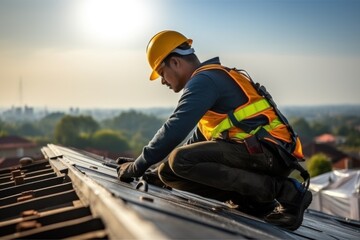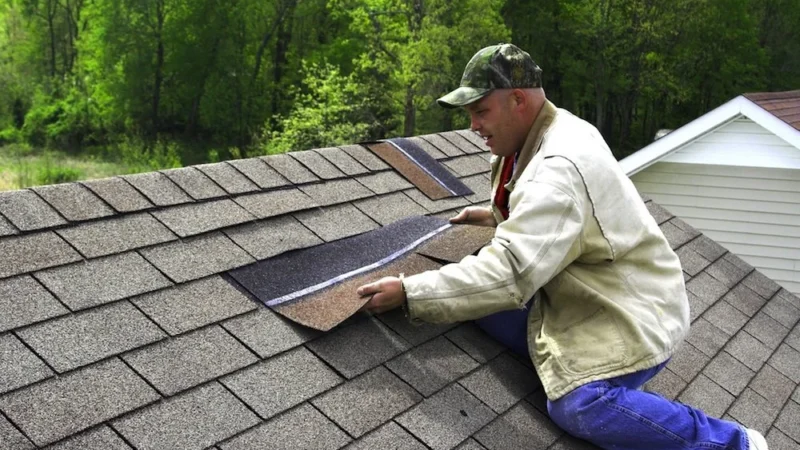What Is Roofing?
The roof protects the structure of a building from rain, snow, sunlight and extremes of temperature. It also carries water away from the building, through gutters and downspouts.

The skeleton of the roof is a frame of wood called the decking or sheathing. Sheathing is usually plywood or oriented strand board. For more information, visit https://www.northportflroofing.com.
A roof’s material is an important part of the overall protection it provides a building. Roofing materials range from natural products such as thatch and slate to manufactured options like asphalt shingles and polycarbonate sheeting. Many roofs also include a vapor barrier and flashing to help prevent water from damaging the underlying structure.
A wood roof is attractive and durable, but it is costly and not as long-lasting as some other roofing materials. It’s also not ideal in areas that receive a lot of moisture or where wildfires are a risk, and it requires a lot of maintenance.
Metal roofs are popular for their durability and strength. They are often made from aluminum or steel and can last for a very long time. They can be very expensive though, especially for larger homes.
Membrane roofing is an alternative to shingle and tile roofs, and is typically used on flat or low-sloped buildings. It comes in rolls that can be unrolled and nailed down over the existing roof. Membrane roofs are easy to install and often do not require much maintenance, but they may be more prone to leaks than other types of roofing.
The most common type of roof in the States is an asphalt shingle. These are designed to be durable and attractive while remaining affordable. They are also resistant to abrasions and chemicals.
Felt is another alternative to shingle and is often used as a waterproofing underlayment. It is a paper-like substance that helps keep the other layers of the roof protected from moisture and other harmful elements. Felt can be made from recycled tires or other sources of rubber and typically includes binders, UV (ultraviolet light) inhibitors and color.
Slate is a natural roofing material that is very durable and energy-efficient. It is also fire-resistant and has a very low embodied energy. Slate is a costly option, but it can last for several hundred years with minimal maintenance.
Installation
Any home part is subject to the elements, but your roof takes the brunt of it. Wind, rain, snow, bitter cold, intense heat, and sunlight all wreak havoc on the exterior of your house, but a well-designed and properly installed roof can withstand these assaults and keep your family warm and dry.
When choosing a roofing contractor, ask about their experience and references. Also, check with your homeowners insurance company; they may have a list of preferred contractors. Also, some manufacturers offer credentialing programs, and this can often help you find a contractor with more training in installing their product.
The installation process begins with putting down an underlayment. The contractor will then nail the first row of shingles to the underlayment. The nails will be close together at the edges and spread out more towards the middle of the shingle. The shingles will then be cut to length and nailed in place with a special roof nailer.
Flashing is then put in place around chimneys and where roofing planes meet. A roofing professional will also add flashing to the areas where plumbing vents protrude through the roof or skylights are installed. These areas are particularly vulnerable to leaks, and a good installation can prevent these problems. In addition, a roofing professional will waterproof the valleys, which are the areas where two slopes of the roof meet. This can be done in the same way as waterproofing the eaves or dormers, with underlayment and felt paper. The gutters will then be nailed to the roof and covered with a protective trim.
Maintenance
Roofing is the outer covering of a building structure that protects it from rain, snow, sunlight, and wind. It can be made of many different materials, including shingles, metal, tiles, or thatch, depending on the architectural style, climate, and budget. A well-constructed and maintained roof can increase the life of a building and help preserve interior valuables.
A thorough roof inspection should be performed on a regular basis to identify problem areas early. A checklist should be developed and tailored to each roof’s specific requirements. This checklist can then be used as a specification for bid solicitation for future maintenance work. A checklist can also serve as a record of the condition of the roof over time.
The first step in maintaining a roof is to remove debris. A clogged gutter system can damage the roof, and debris can block the flow of water to drains, which can cause premature damage. This is particularly important after heavy rainfalls and storms.
In addition to removing debris, the roof should be cleaned on a regular basis. This includes a thorough inspection of the chimney to remove creosote buildup, which can cause a fire hazard. It is also important to ensure that the seals around roof penetrations (such as skylights and vent pipes) are in good condition.
Leaks can be caused by damaged shingle tabs, cracked or missing mortar, or deteriorating caulk. A trained professional can inspect the integrity of the roof and recommend any needed repairs.
The flashing, which is the material around the chimney and where the roof planes meet, should be examined for cracking, openings, crazing, or leaking. If necessary, the flashing can be re-caulked to prevent leaks.
A regular cleaning of the drains can help prevent clogging, which can cause moisture and mold to form on the roof surface. The scupper boxes should also be cleared of debris, as they are an important means of water drainage for the roof.
Finally, the trees should be trimmed regularly to eliminate the risk of limbs falling onto the roof during heavy storms. This can be especially important after major weather events, such as hurricanes or tornadoes.
Repairs
If you notice a leak, discoloration or other damage to the roof, it’s important to act promptly. Even small leaks can lead to mold, mildew or rot in the structure. It’s also possible that water from a leaking roof can damage your furniture, carpeting or wallpaper. Leaks are often caused by old or worn shingles, flashing or other roofing materials.
Depending on the severity of the damage, you may be able to repair the roof yourself or hire a professional. First, make sure to get up in the attic or crawl space (or wherever you can access your roof from inside your house) and check for damage. Look for damp spots in the ceilings, walls and floors, especially around chimneys, pipes, vents, skylights and old flashing.
You should also take a closer look at any damaged areas of the roof, particularly the soffit, main roof and valley. The most common cause of leaks is damaged flashing. To fix the problem, start by removing any existing flashing that’s damaged or detached. Then, use the removed piece as a guide to cut and bend a new flashing strip to fit over the hole. If nails were used, nail the new flashing in place, and then cover the nails with a layer of sealant or roofing cement.
When it comes to repairing a roof, re-roofing is one of the most common home improvement projects. It’s a quick and cost-effective way to restore your roof, but it doesn’t last as long as a replacement. Plus, you may not be able to match the exact color, style and brand of the shingles with those of your house, which can hurt curb appeal.
If your roof is damaged, it’s best to contact a professional roofing contractor. They can inspect your roof and determine the extent of the damage, as well as any underlying issues that might need to be addressed. Plus, they can offer advice on energy-saving and eco-friendly options for your roofing. They can also help you get approved for a home equity loan to fund the project.





